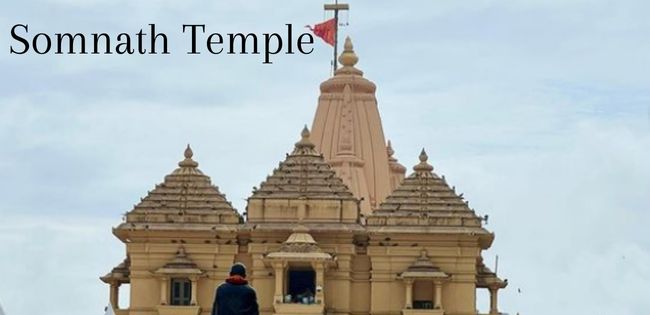About:
The Somnath temple, also called Somanātha temple. Deo Patan is a Hindu temple located in Prabhas Patan, Veraval in Gujarat, India. It is one of the most blessed pilgrimage sites for Hindus and is believed to be first among the twelve Lingam shrines of Shiva.The temple was reconstructed several times in the past after repeated destruction by multiple Muslim invaders and rulers, particularly starting from an attack by Mahmud Ghazni in the 11th century. It is unclear when the first version of the Somnath temple was built with estimates diversified between the early centuries of the 1st-millennium to about the 9th-century CE.

The Somnath temple was actively studied by colonial era historians and archaeologists in the 19th- and early 20th-century, when its ruins demonstrate a historic Hindu temple in the process of being converted into an Islamic masjid. After India’s independence, those ruins were demolished and the present Somnath temple was reconstructed in the Māru-Gurjara style of Hindu temple framework. The immediate Somnath temple Its reconstruction was started under the orders of the first Home Minister of India Vallabhbhai Patel and completed in May 1951 after his death.
Temple History
The Temple is backed by a harlequin and elaborate history. It is said the first version of this temple came into being even before the start of Christian era. The second version of this temple came into being under the resourcefulness of the Vallabhi king around 408AD-768AD. This temple is often referred to as the ‘eternal shrine’ because historical records say that this temple has been destroyed several times by invaders and has been revitalised several times too.

Archaeological investigations state that the temple of Somnath had been rebuilted nearly thrice before the raid of Muhammad Ghaznavi in the year 1026. Also, it is said that later the temple was attacked three times more. Thus the temple was attacked and destroyed as many as 6 times until the present 7th version emerged.
The latest rebuilding of Somnath temple was done in 1947 under the initiative of Sardar Vallabhbhai Patel; the then deputy PM. Prabhashankar Sompura was chosen as the architect and thus the present day Somnath temple came into being. On 11th May, 1950 the then president of the country, Rajendra Prasad inaugurated the temple.
Some of the ancient texts tell that the temple was built for the first time in gold by king Somraj during Satya Yuga. In Treta Yuga, Ravana had built it out of silver while in Dwapara yuga lord Krishna had built it out of wood. Later King Bhimadev had built the temple out of stone. That is the claim of some of the ancient scriptures of our country.
Temple Myths and Legends
Somnath temple has many fascinating stories associated with it and that definitely excites the curiosity of all god lovers and inquisitive tourists.. A mythological tale tells that Chandra or Moon God had undertaken rigorous penance here in order to free himself from a curse given by his father-in-law Daksha Prajapati.
It is said the Moon God was wedded to Daksha Prajapati’s 27 daughters. But out of his 27 wives he only favored Rohini while neglected the rest. Daksha Prajapati was exasperated by the neglect of his other daughters thus cursed the moon that he would soon lose his entire luster. The anxious moon then came down to Prabhas Patan to pray to Lord Shiva and get rid of the curse. Lord Shiva ultimately got impressed by his devotion and freed him of the curse. Out of gratitude Moon God set up a Jyotirlingam at this place which later became famous as the Somnath temple.

Why this temple famous for
- The modern day Somnath Temple was built over five years, from 1947 to 1951 and was opened to the public by then President of India Dr Rajendra Prasad.
- The Shivalinga in the temple is believed to have safely hidden within its hollowness. The famous Syamantak Mani, the Philosopher’s stone, which is associated with Lord Krishna. It was said that it was a magical stone, which was capable of producing gold. It is also believed that stone had wizardry and bewitchery properties and could create a magnetic field around itself that helped it remain floating above ground.
- The temple finds its instance in the most ancient texts of Hindus like Shreemad Bhagavat, Skandpuran, Shivpuran and Rig-Veda which manifest the importance of this temple as one of the most popular holy expedition sites in India.
- According to history academics, the site of Somnath has been a holy expedition site from ancient times as it was said to be the convergence point known of three rivers, Kapila, Hiran and the mythical Saraswati. The convergence was called Triveni Sangam and is believed to be the place where Soma, the Moon god bathed and recover his lustre. The result is consider to be the waxing and waning of the moon or the waxing and waning of the tides at this sea shore location.
- The legend has it that the initial structure of the temple was first built by Moon God who constructed the temple with gold. The Sun God used silver for its construction, whereas Lord Krishna made it with the help of sandalwood.
- According to Hindu scholar, Swami Gajanand Saraswati, the first temple was built 7,99,25,105 years ago as obtained from the traditions of Prabhas Khand of Skand Puran.
- The temple suffered destruction at the hands of Mahmud Ghazni in 1024, Khilji’s army in 1296, Muzaffar Shah in 1375, Mahmud Begada in 1451 and Aurangzeb in 1665.
- The temple is said to be situated at such a place that there is no land in straight-line between Somnath seashore till Antarctica. In an inscription in Sanskrit, found on the Arrow-Pillar called Baan-Stambh Build on the sea-protection wall at the Somnath Temple which happens to be the first point on land in the north to the south-pole on that particular longitude.
- According to the Skanda Purana, the name of Somnath Temple will changed every time the world is reconstructed. It is believed when Lord Brahma will create a new world after ending the recent one, Somnath will acquire the name of Pran Nath Temple.










 Shri Eklingji Temple in Udaipur, Rajasthan – A Sacred Marvel of Mewar
Shri Eklingji Temple in Udaipur, Rajasthan – A Sacred Marvel of Mewar 








